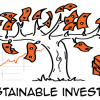Transcript
5 Principles for Social Sustainability
We know humans are dependent on ecological and social systems to meet their needs. From previous research we understand fairly well how ecological systems function and the basic mechanisms by which humanity damages them systematically. But what about social systems?
Some years ago, a group of researchers in Sweden set out to answer this question. Here’s the story of what they learned. <<INTRO>>
A social system is made up of individuals connected through relationships and interactions. Think about a city, for example, from a birds-eye view with people going about their everyday life. Can you see the intricate web that their interactions is weaving?
This web of relationships is ever-changing, with new properties emerging from individual interactions that cannot be ascribed to the individuals, and that are hard to predict in detail. It’s complex.
Individual and collective behaviour mutates and changes. It’s adaptive. Think of how behaviour has changed along with new possibilities following from technical innovations, for instance. Today, interaction through advanced Information and Communication Technologies is common, also among people who have lived most of their lives without computers, tablets and mobile phones, and many have even begun to forget how daily life was possible without such interaction possibilities.
So, social systems are complex and adaptive.
This way of looking at social systems can be applied to all scales, from the global social system to smaller, more specific systems such as nations, communities, companies, and families. The key feature that allows such systems to function and evolve despite unpredictable change is called adaptive capacity. Partly this is about the capacity of the system to withstand stresses up to certain limits, and partly it is about the capacity of the system to reorganize or transform when such limits are trespassed, and still be able to provide its essential functions.
The researchers identified a number of essential aspects of adaptive capacity in social systems. A major aspect is trust. It is impossible for one or a few individuals to fully understand or control the entire complex system they are part of. We must as individuals often rely on others to make decisions and choose viable alternatives for collective adaption. So, for effective adaption, trust between the individuals is needed, and also between the individuals and their institutions in a community or society. Trust is often termed the fabric that binds a social system together.
Another important aspect is diversity, here in the sense of different personalities, talents, fields of expertise, cultural mindsets, gender, ages etc. Such diversity amongst the individuals, especially if trust between them enables efficient cooperation, implies more variety in response options to unpredictable change. Since we don’t know exactly what will be needed in the future, having many options is a good strategy.
Other essential aspects include capacity for learning, capacity for self-organization and common meaning. Complexity and unpredictable change require we learn quickly in order to be able to adapt flexibly and quickly.
And being able to reorganize without centralized control is important since it also facilitates quick responses when a sudden change occurs. Finally, as with trust, sharing a common meaning also binds a social system together. With a strong sense of shared meaning, people can put up with difficult circumstances for long, and endure in social cohesion to help each other
Having identified such essential aspects of adaptive capacity of a social system, the researchers went on by investigating by what mechanisms those aspects can in principle be degraded so as the system is not sufficiently adaptive anymore? The idea of searching for such mechanisms was to then put a “not” in front of them, and by doing so, obtain principles for social sustainability.
Through extensive literature studies, interaction with other scientists in many disciplines as well as sustainability practitioners, and modelling of well-functioning as well as ill-functioning social systems, the researchers derived five such generic mechanisms of destruction, in the form of social constructions upheld by those with power. By putting a not in front of those mechanisms, the researchers formed the following basic principles for social sustainability:
In a socially sustainable society, people are not subject to structural obstacles to…
In a socially sustainable society, people are not subject to structural obstacles to…
…health. This means that people are not exposed to social conditions that systematically undermine their possibilities to avoid injury and illness (physically, mentally or emotionally). For example by dangerous working conditions or insufficient wages.
…influence. This means that people are not systematically hindered from participating in shaping the social systems they are part of. For example by suppression of free speech or neglect of opinions.
…competence. This means that people are not systematically hindered from learning and developing competence individually and together. For example by obstacles for education or insufficient possibilities for personal development.
…impartiality. This means that people are not systematically exposed to partial treatment. For example by discrimination or unfair selection to job positions.
…meaning-making. This means that people are not systematically hindered from creating individual meaning and co-creating common meaning. For example by suppression of cultural expression or obstacles to co-creation of purposeful conditions.
For the interpretation and application of these principles, some important points should be remembered. Structural obstacles in this context mean social constructions – political, economic and cultural – which are firmly established in society, upheld by those with power (political, economic or other forms), and which are, due to a variety of dependencies, difficult to overcome or avoid by the people exposed to them. And it should be emphasized that the preamble with structural obstacles is critical and belongs to the principles. Everyone having perfect health, perfect levels of influence, etc., is utopic.
But for a social system to be sustainable, people cannot be exposed to social conditions that systematically hinder them from avoiding injury and illness, from participating in shaping the social systems they are part of, etcetera. It is not one-off actions that cause unsustainability,
but the systematic nature of structural obstacles – obstacles ingrained and upheld in political, economic and cultural systems. Environmental circumstances that nobody can control, may lead to hard impacts on a society without people necessarily loosing trust in each other or in their institutions
Finally, a hopeful point. Generally, the social cohesion and the social adaptive capacity can be strong also in times of environmental difficulties, caused by, for example, natural catastrophes or other external factors. And in particular in the face of increasing ecological pressures caused by humanity, we now need leadership that promotes adaptive capacity in social systems more than ever.
There you have it: 5 principles for social sustainability. Added up to the previously established 3 principles for ecological sustainability, you have a set of 8 principles for sustainability.






